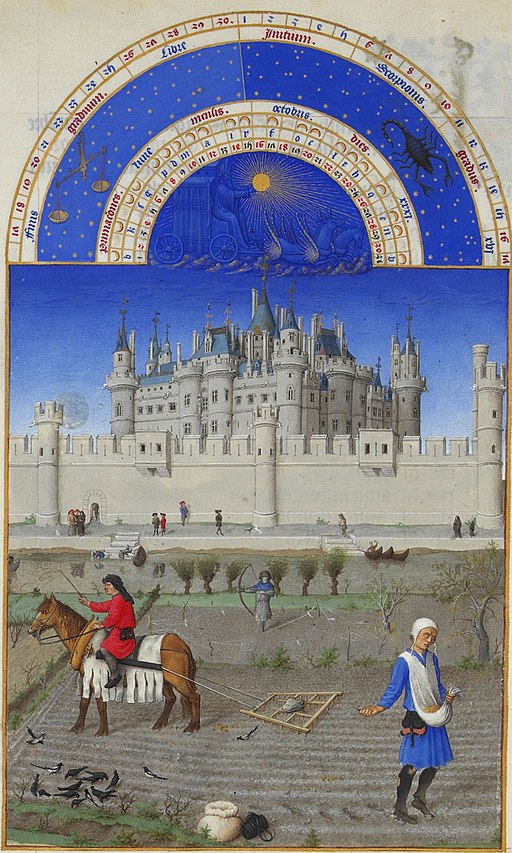This is another in the series of illuminated paintings in a book of prayers produced by the
Limbourg Brothers (1385-1416) for
John, Duc de Berry (1340-1416) the third son of King
John II of France. This particular one has familial connections for the Duc.
The book is called the
Très Riches Heures du duc de Berry and it's one of the finest examples of French Gothic manuscript illumination surviving to the present day. It's belonged to various people over the years and is now housed at the Musée Condé in Chantilly, France.).
The very fine miniature paintings of landscapes that it contains represent the direction of landscape painting taken by early Netherlandish painters such as the Limbourg Brothers - who were the first to paint landscapes with accuracy.
 Très Riches Heures du duc de Berry Folio 10, verso: October - Sowing the Winter Grain
Très Riches Heures du duc de Berry Folio 10, verso: October - Sowing the Winter Grain
by the Limbourg brothers [Public domain],via Wikimedia Commons
Date: between 1412 and 1416 and circa 1440
Medium: painting on vellum
Dimensions: Height: 22.5 cm (8.9 in). Width: 13.6 cm (5.4 in).
This is a translation from the French of a description of the scene.
The scene in the foreground represents peasant sowing. At right, a man sows on the fly. Magpies and crows pecking seeds which have been sown, near a white bag and a satchel. Behind a scarecrow-like archer and son stretched on which are hung feathers are intended to deter birds. On the left, a peasant on horseback crosses the harrow on which rests a stone that allows the teeth to penetrate deeper into the earth. It thus covers the grains which have been sown. In the background, the painter has represented the Palais du Louvre. Castle in the center, there are, besides the central tower which housed the royal treasury while the eastern side right, supervised by the Taillerie tower and the tower of the chapel, and left the southern facade with two towers twin center. The whole is surrounded by a wall punctuated by three towers and two bretèches visible here. On the shore, characters converse or walk
It's odd that the description neglects to mention the River Seine!
Interestingly the building in the background is the
Louvre Palace. There are three reasons for the significance of this miniature painting of the Louvre in an illuminated book of this sort:
- First the idea behind the paintings of different places in the series of different miniature paintings of landscape scenes for the different months was they represented places known to the Duc de Berry. They were castles he owned or places - like the Louvre Palace - that he had visited. In this way the book became personal to the man himself.
- Second, the Louvre is the palace built by King Charles V and where he housed his enormous library of 1,200 volumes where books of significance - translated into French - were kept as a symbol in part of this status as King.
- Third, King Charles V is the Duc de Berry's elder brother and it would therefore appear that the two brothers had a shared love of books.
Thus this painting may represent a visit by the Duc to his brother one October to see that Library. At the very least, the painting is a compliment to his brother the King in his endeavours to build a library of great books in the Louvre.
(Note: I've just worked all this out reading around the net - I've no idea whether it's true but it makes sense to me!)
That said, this painting still purports to be a painting of the landscape in the middle of Paris in the fifteenth century - with the foreground being the scene on the West Bank. However. it's unclear whether the Limbourg Brothers ever saw the Louvre Palace
Links:




